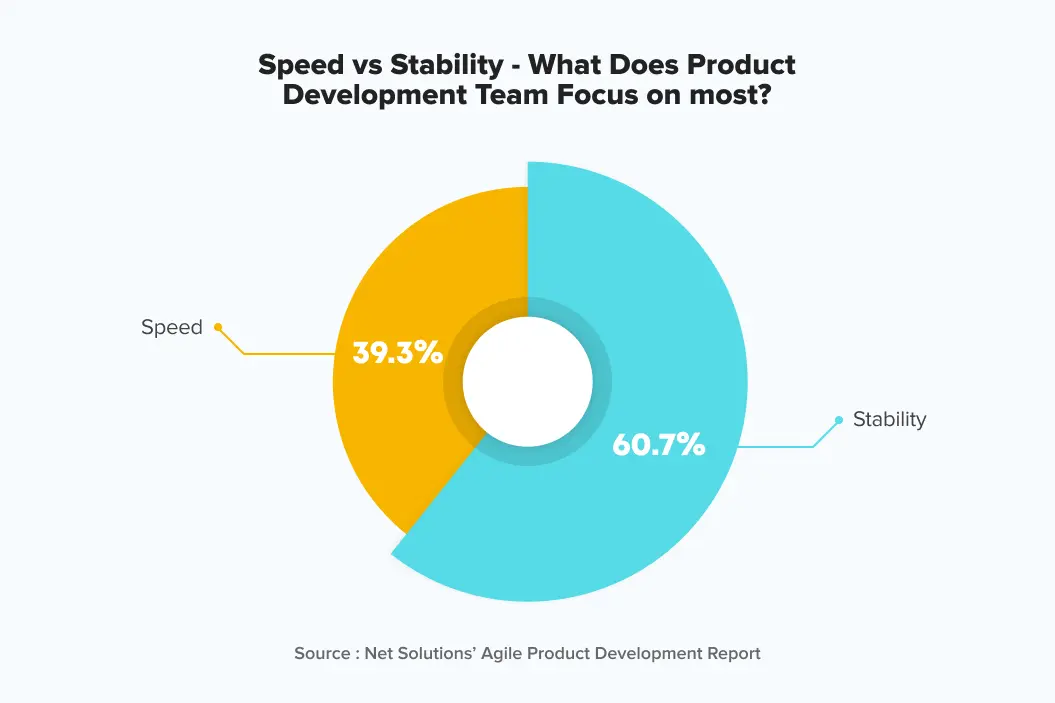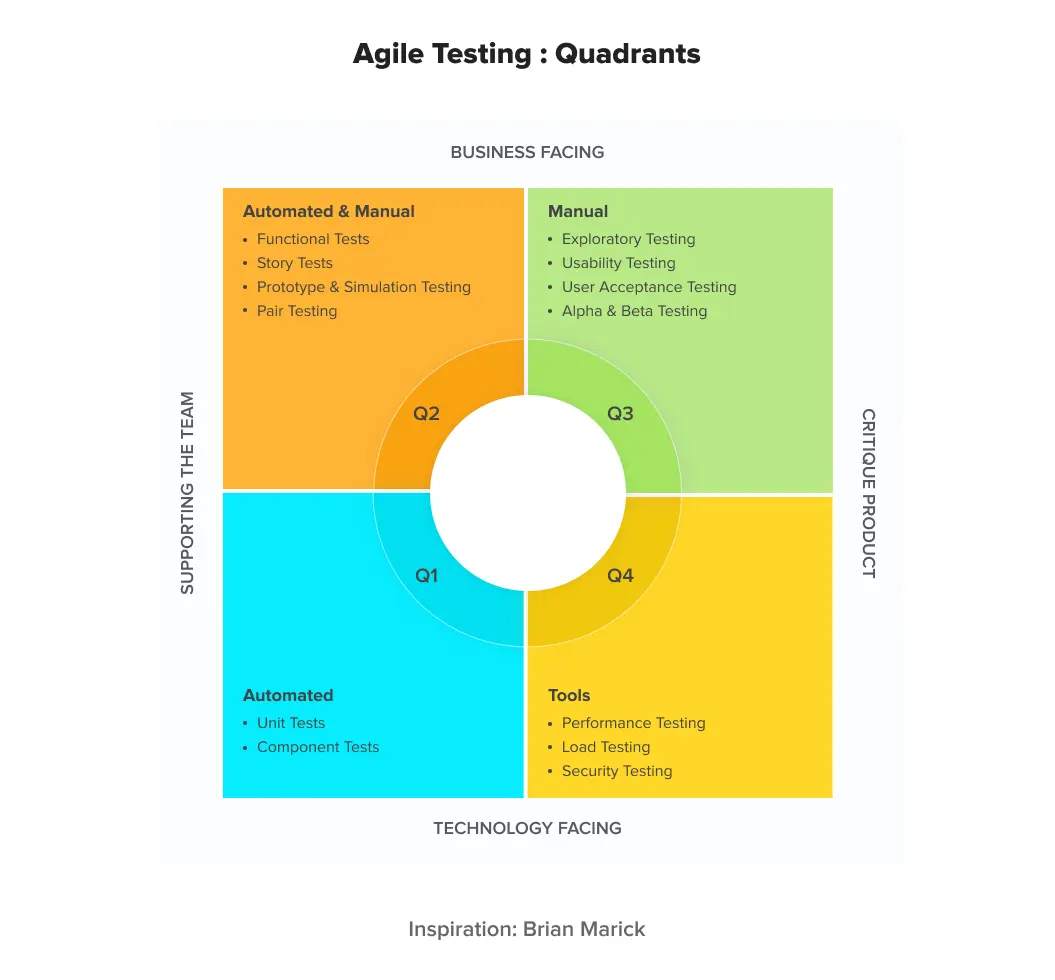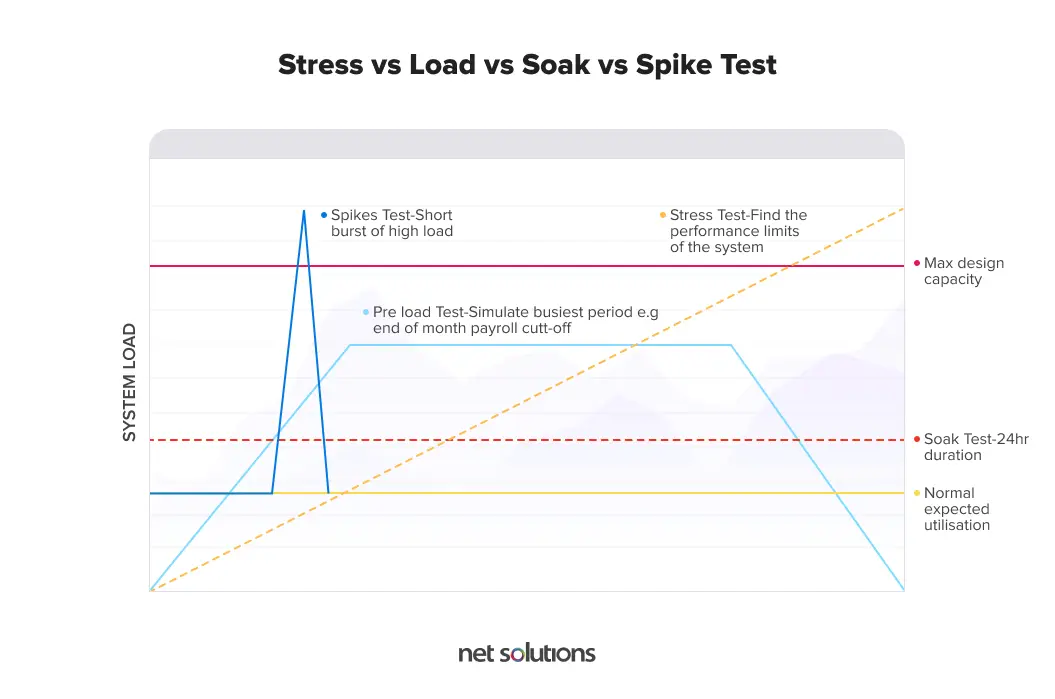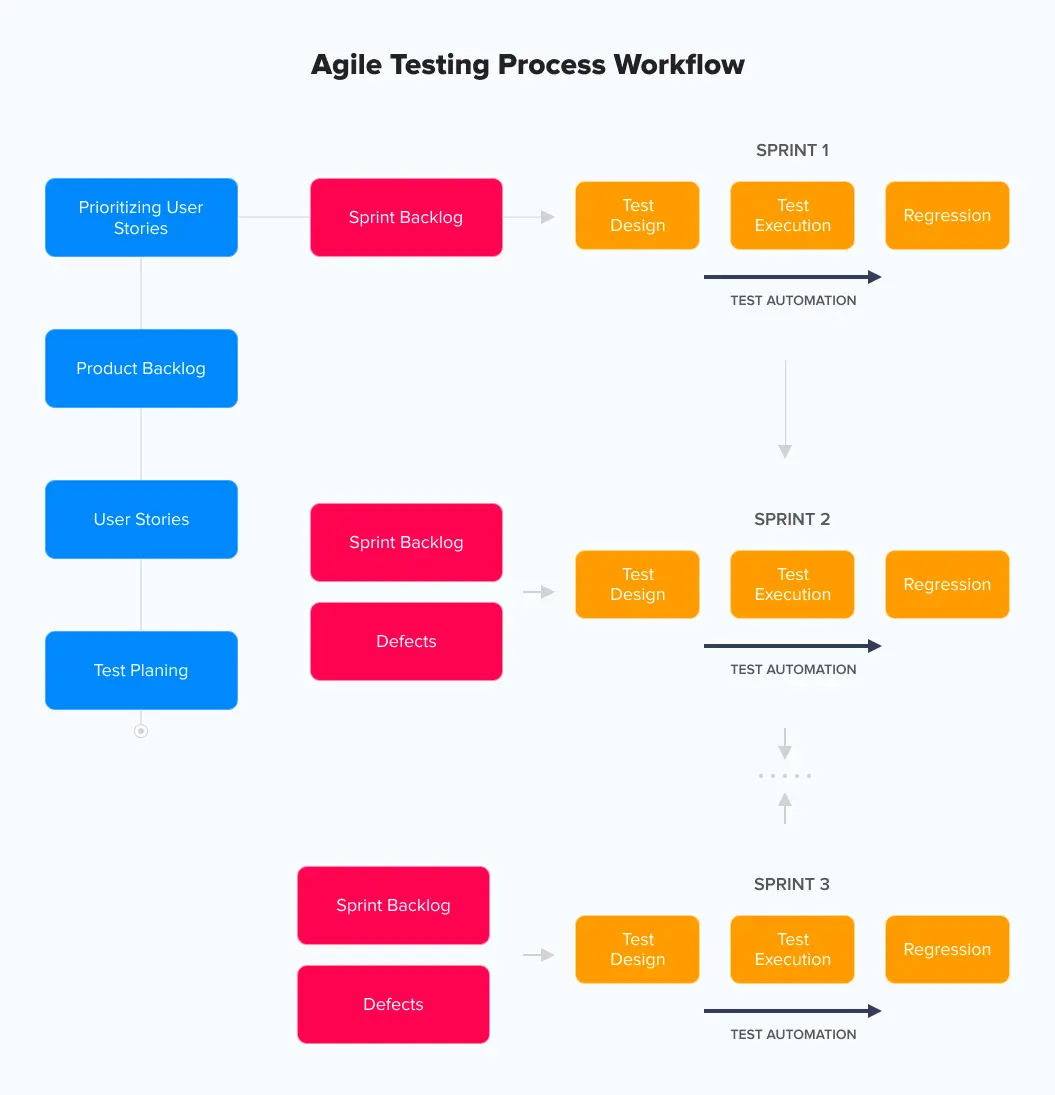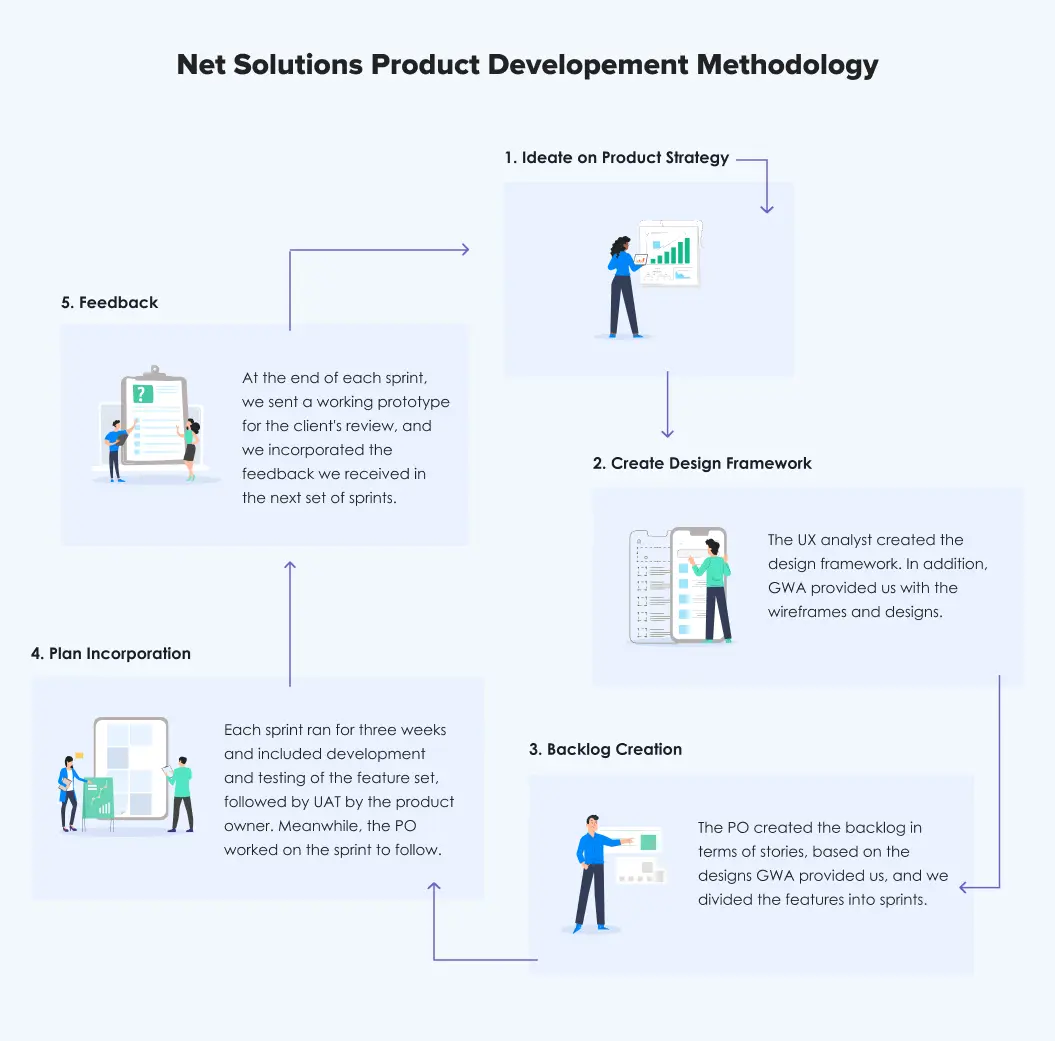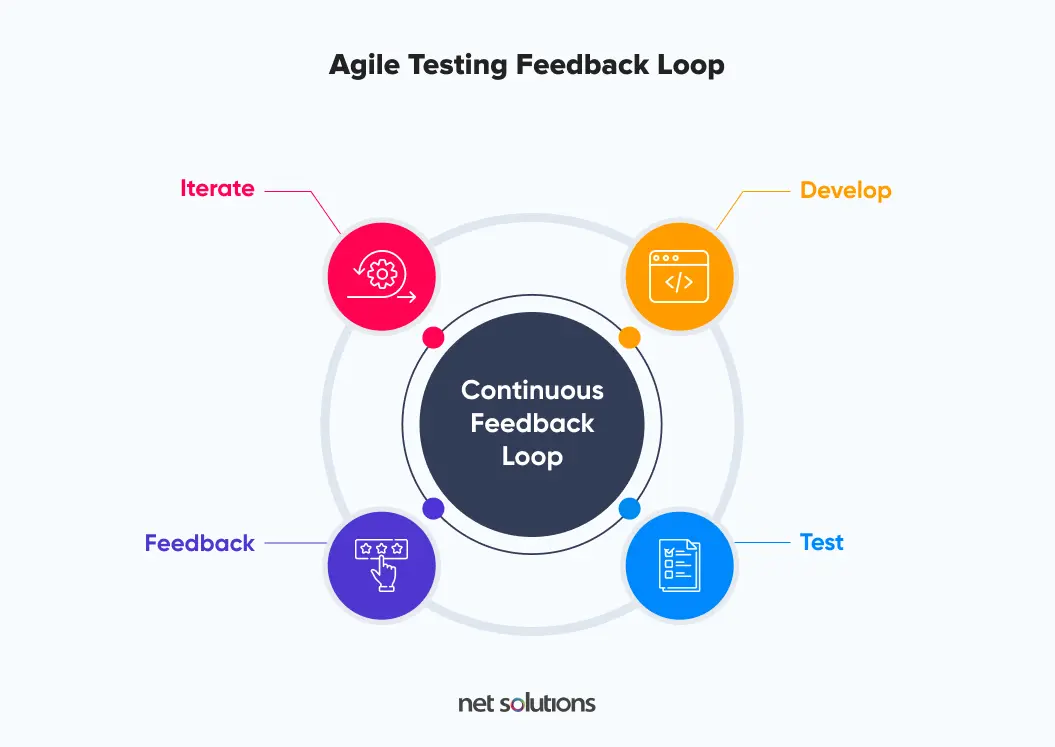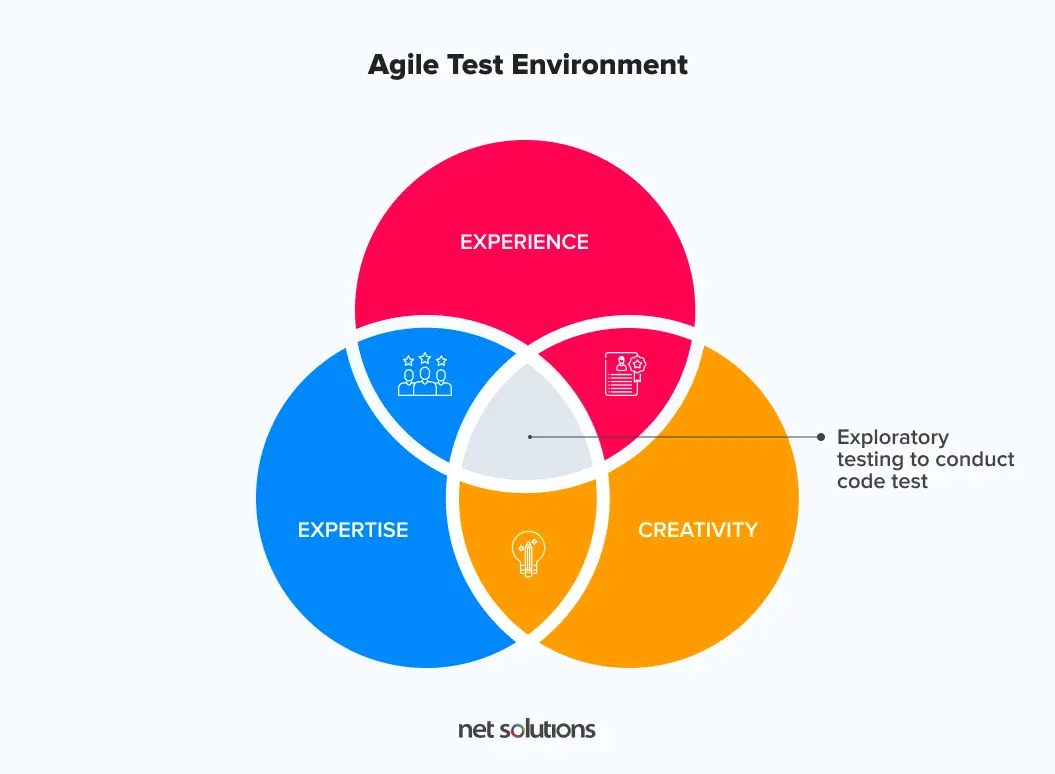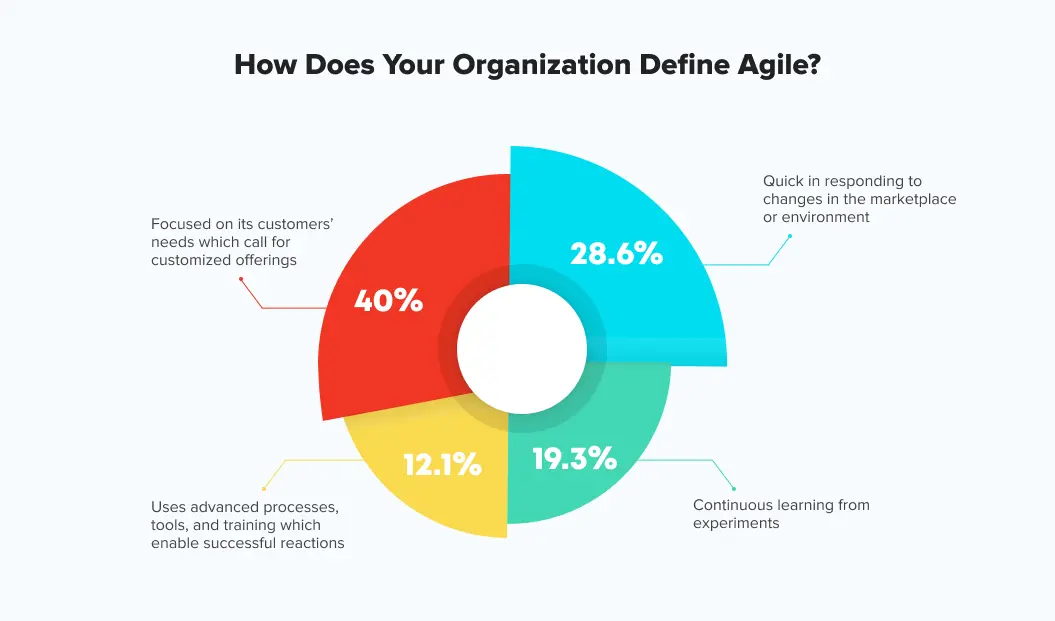Agile testing is one of the vital elements of the software development lifecycle (SDLC) that enables the delivery of quality software in short timelines and tight budgets.
With a continuously shifting digital paradigm and customer behavior, enterprises that are able to keep pace with rapid advancements in technology and processes are witnessing positive changes in their business environment.
Net Solutions’ State of Digital Transformation 2020 report states that customer-centric vision is a tangible reality for more than half of the business leaders, pushing the organizations to become leaner.
The urgency to push a product to market at the right time, satisfying the customer needs, has increased the demand for agile software on the one hand and shrink the Quality Assurance (QA) and Testing budget on the other hand: from 35% in 2015 to 23% in 2019. While shipping as fast as possible can give a business an edge over the competition, there is one thing that is usually handled with levity: Security.
Software testing tends to operate in silos, making collaboration and integration a real challenge, thus failing to find the right balance between quality, speed, and cost. To drive true value from Agile software development methodology, it is important to adopt Agile testing – a testing solution embraced early and in-depth: implemented across software lifecycles and architecture layers.
What is Agile Testing?
Agile Testing is a holistic approach to “bake in quality” to the digital product.
Agile Testing takes on the principles of agile manifesto and values to speed up the testing process while ensuring collaboration among the testers and developers towards the common goal — quality software development.
52% of respondents say they prepare and execute tests as early as possible to speed up and optimize testing in Agile and DevOps development. – World Quality Report, 2020-2022
In simple words, in the case of Agile testing, testing becomes a vital part of the sprint development, which eventually drives quality. Agile testing bridges the gap between the development and the testing phase of the SDLC, ensuring that the quality software is delivered at speed and scale.

By now, you must be clear about what is Agile testing. Now, let’s discuss the importance of Agile testing in the software development process.

We respect your privacy. Your information is safe.
How is Agile Testing Different from Waterfall Testing?
Agile software testing is different from Waterfall testing in a way that Agile testing becomes part of the SDLC from the requirements gathering stage itself. Before beginning the software testing, the detailed design documents get approved in order to build the test case.
Both testing and coding happen incrementally and iteratively (in sprints), making sure that each feature delivers the required stability and adds quality to the final digital product.
Agile Testing vs Waterfall Testing
As discussed in the section ‘What is Agile Testing?’, the quality is actually baked in the case of Agile testing, contrary to what happens in Waterfall testing, where quality is not baked and tested out, and we end up creating a bug database, eventually letting the ‘bugs’ to die.
To get a better understanding of Agile testing vs Waterfall testing, here is a table that enlists the differences between Agile testing and Waterfall testing:
| 1. Testing only starts after the development process is over. Here the development and testing phases are entirely independent of each other | Testing occurs as a recurring activity throughout the development process. That is, development and testing are done side by side |
| 2. Developers and testers work independently without much collaboration. | Promotes cross-functional setups where developers and testers work together towards developing a quality product |
| 3. Testers are not a part of the requirement gathering phase | Testers are a part of the requirement gathering phase. This helps in creating test cases in advance |
| 4. Regression testing is only conducted at the end of the development process | Allows running regression testing as and when a new feature or requirement is added |
| 5. Time spent is more on development and testing phases | Time spent is comparatively less on development and testing phases as they occur side by side |
4 Agile Testing Quadrants
The following are the four quadrants of Agile testing, as introduced by Brian Marick. It enlists the different types of software testing that fit the various stages of the development process.
- Agile Testing Quadrant 1: Unit Level, Technology Facing
- Agile Testing Quadrant 2: System Level, Business Facing
- Agile Testing Quadrant 3: System or User Acceptance Level, Business Facing
- Agile testing Quadrant 4: System or Operational Acceptance Level, Technology Facing
Quadrant 1: Unit Level, Technology Facing
Intent: Helps support the developers
Nature of Conduct: Can be automated
1. Unit Tests
Unit testing is an Agile Testing process for checking the quality and efficiency of individual user stories, i.e., for a specific feature built by the developers. In short, it checks the user story from the design and technical perspective. The Agile developers themselves can also run unit tests.
For example, if the code for the authentication and login user story is ready, the unit testing will be run to check if the login works as per the expectations.
2. Component Tests
Component testing in agile is a testing process where the individual objects or parts of the user story are tested individually. It can be done in isolation or in conjunction with other components that make up user stories in agile.
For example, if we again refer to the authentication and login user story, checking the different components on the screen, i.e., options like login with email, Facebook, or even your phone number will be the various components that need to be tested.
Quadrant 2: System Level, Business Facing
Intent: Validates product behavior
Nature of Conduct: Automated or manual
1. Functional Tests
Functional testing is a type of black-box testing where the software system is tested to check whether it adheres to the specified functional requirements. The loopholes in performance are identified and reported to the developers. This test focuses on examining the basic functionality, usability, and accessibility of the application.
2. Story Tests
Story tests are run to check if all the user stories are accommodated as a part of the software. When the stories are created initially, the corresponding story test cases are also developed alongside that, in turn, act as story acceptance tests. Each of the user stories adds a new test to the story test stack.
3. Prototype & Simulation Testing
These tests are mainly conducted to check the design and the UX flow of the software. Any defects on the visible side of the application are identified and reported so that the prototypes can be reworked before launching the MVP. These types of tests, if successful, also help attract seed funding for the product.
4. Pair Testing
Pair testing is a practice where two people work simultaneously and in the same space to test the software. This type of testing can be conducted by a tester-tester pair or even a developer-tester pair. Pair testing is foolproof and offers speedy results.
Quadrant 3: System or User Acceptance Level, Business Facing
Intent: Focuses on real-time scenarios
Nature of Conduct: Manual
1. Exploratory Testing
Exploratory testing is a type of testing where the test cases are not created in advance. Testing is conducted during the ongoing development process. However, the testers generally brainstorm about what tests they will perform before the process. These tests are mainly based on the experience, learning, and creativity of testers.
2. Usability Testing
Usability testing is a type of testing where a set of end-users step in to test how easy it is to use and navigate the user interface. These users are assigned tasks that they need to perform to see how the application works. However, testers might step into the user’s shoes too to evaluate the product from their perspective.
3. User Acceptance Testing
User acceptance testing is conducted by the end-users or clients to check whether their requirements have been met, and pain points have been addressed. This type of test checks the wholeness of the software and its ability to perform as intended.
4. Alpha & Beta Testing
The tester conducts alpha testing before the software product gets launched in the market. All the bugs and inconsistencies are identified and fixed before the actual launch.
In beta testing, the product is released to minimal end users who test and provide feedback. Such tests help mitigate product failure risks. In Agile Testing, alpha and beta testing should be conducted with every release.
Quadrant 4: System or Operational Acceptance Level, Technology Facing
Intent: Focuses on software ilities
Nature of Conduct: Automated testing tools
1. Performance Testing
Performance tests are conducted to test the speed, responsiveness, intuitiveness, and stability of the software product. In Agile Testing, performance testing can be checked at the end of each sprint that delivers a user story. This ensures a good speed of testing and timely delivery of high-performing products or fragments of the product.
2. Load Testing
Load testing is conducted to check the working of the software under specific load conditions. This type of testing is generally done to check the application’s performance under normal and peak conditions. Automated Agile Testing tools are used for load testing, and should be performed at the end of every sprint to check the performance of every user story.
3. Security Testing
Security testing is a type of test that checks the robustness of the software system and its level of protection against intruders. Security as a part of Agile Testing should be conducted using automated tests weekly or monthly.
What is the Importance of Agile Testing?
90.7% of the product development teams witness scope creep while building a Minimum Viable Product (MVP). – Net Solutions’ Agile Product Development 2020 Report
Treating testing as an afterthought — performed at the end of the development process — triggers a number of project challenges:
- Schedule overruns
- Cost overruns
- Poor developer-tester communication
- Poor resource allocation
- Overlooked functionalities
When incorporated into the SDLC, Agile Testing helps mitigate these challenges, thereby building transparency throughout the software development process. The importance of Agile Testing lies in the fact that following Agile methodology in testing addresses defects where they were injected, not where they were detected.
The focus of Agile methodology in testing is to incorporate robust measures and complete visibility into the software development lifecycle, providing informed data on where to drive targeted improvements.
Agile Testing Pyramid
The Agile testing pyramid is a structure laid by Mike Cohn in his book Succeeding with Agile. It helps visualize different layers of Testing, each with different types of software tests.
The Agile testing pyramid also explains the number of tests to be performed each year in order to get a quality product. The Agile testing pyramid is made up of three major components:
- Unit Testing: It is the foundation of the solid software test strategy.
- Service Tests: It deals with testing the services of an application independently from its user interface.
- UI Tests: These tests aim to check whether the user interface of your application is working correctly or not.
Considering today’s post-digital era, the Agile testing pyramid appears to be misleading because of its over-simplicity. However, because of its simplicity, the Agile testing pyramid is considered an ideal concept to start from for new QA testers.
What is Agile Testing Life Cycle?
The Agile testing lifecycle is a set of processes and best practices that the team adopts to deliver iterative quality feedback to the development team. It helps detect and plug any functional and non-functional mismatches, at the early stages, between the project requirements and the project delivery.
The stages of the Agile testing lifecycle are based on the Agile testing pyramid. Here is how the Agile testing teams apply best practices and methodologies to deliver a quality product at speed and scale.
1. Sprint Planning
A sprint is a pre-decided time period within which the team members working on the project needs to complete a user story.
Before a sprint kick starts, the product owner, developers, and testers discuss what needs to be accomplished in each of the sprints and the consecutive sprint goal. The daily standups are also a must among the agile teams throughout the Product Development process.
2. Building a Test Case Design
The testing teamwork maintains a cadence with the development team, i.e., while the development team is building a user story, the testing team develops test-case designs. A test case design enlists how you will go about setting up the different test cases. These designs ensure that the quality tests stick to the laid down process.
The documented test cases are then handed over to the development team for review and also so that both the teams involved can decide the test cases that can be automated.
3. Testing
As soon as the user story gets completed on the development side, the testing team steps in — to quality check the software. The developers and testers work in tandem to execute testing in an agile environment.
This is done to identify early-stage defects so that the development team can fix the minor ones there and then, and the rest can be fixed in the following sprints on a priority basis. As for the automated test cases, they are run across the development process daily.
4. Ensure Product Stability
Agile is associated with iterative development, i.e., new requirements can be accommodated at any stage of the development process without adding to the complexities.
The testing team’s responsibility is to determine when to stop the requirement flow and ensure product stability.
5. Manual & Automated Regression Testing
The manual and automated test cases are run to check the quality of the code after new user stories are added to the agile development process.
These tests ensure that the new requirement additions do not disturb the software’s overall structure and functioning.
How Net Solutions Helped GWA Group Become a Modern, Competitive Tech-powered Business?
Style and substance are two areas that leading home improvement specialists GWA can’t afford to skimp on when they serve their building and construction- sector clients. They turned to Net Solutions for a strategic upgrade and redesign for 11+ websites, portals, and apps.
What are the Benefits of Agile Testing Methodology?
The agile testing process requires continuous integration testing throughout the iterations and test phases. The two critical elements of the Agile methodology in testing are:
- Effective communication
- Test environment availability
The benefits of Agile testing depend on how well you accommodate these two elements of the Agile testing process in your SDLC.
Since Agile testing occurs in real-time, it enables the team to break down silos and collaborate actively during the entire development process that helps the team to identify and forward the issues into executable specifications. It reduces the chances of Agile transformation failures and helps build security-driven software products.
The various advantages of Agile testing are:
- It ensures timely delivery of quality software
- It gives precedence to automated tests that help in regression testing
- It reduces the documentation work significantly
- It ensures that testing estimates aren’t overlooked
- It promotes cross-functional setup and collaboration among the teams
- Test reports can be discussed, and bugs can be addressed quickly with daily standups in place
What are Agile Testing Principles?
The Agile testing principles, mentioned in the following section, are partially derived from the list of principles mentioned in the Agile Manifesto. Also, some Agile testing principles are derived from our more than two decades of product development experience. Here’s the list of the top ten Agile testing principles:
1. Continuous Testing
Software testing is conducted at the end of every sprint. The testing team should collaborate with the development team to continue developing and testing along the entire cycle of the software development process.
2. Continuous Feedback
A developer delivers a user story at the end of every sprint. The developer then passes it on to the testing team. The testing team analyzes the user story and creates a test report. Next, the test report is rolled back to the developing team so that the bugs can get fixed there and then.
This is called a continuous feedback process that follows the process — Develop, Test, Provide Feedback, Iterate, Repeat.
3. Adopting the Whole-Team Attitude
Agile product development should be a result of teamwork. The testers should be communicating and interacting with the developers at all the stages of product development, and vice-versa. One of the most significant benefits of agile development is breaking the silos between distributed teams.
4. Quick Feedback
Agile is synonymous with speed. To ensure timely delivery of software, the Agile Testing team should ensure that quick feedback is delivered after every sprint so that the bugs can be fixed at the earliest. The more delays in the feedback, the more time goes into foolproof product development.
5. Ensuring Software Quality
The objective of the Agile Testing team is to ensure high software quality. The code should be clean, iterative, and should have minimal cruft (unwanted code). This is possible when testers plan and according to the test plan, they test at the end of every sprint so that their tasks stay organized, and they do not feel overwhelmed with testing millions of lines of code at the end of the development cycle. The easier the management, the better the testing, which, in turn, ensures quality.
6. Minimal Documentation
Agile teams often rely on exploratory testing to conduct code tests based on experience, creativity, and expertise. This means that they do not have to rely much on documented processes and test cases, which saves them time and effort while executing the planning process. Thus, in Agile Testing where new requirements can emerge at any time, exploratory tests should be given precedence.
7. Practice Continuous Improvement
As a part of Agile Testing, testers should demonstrate an agile mindset too. They should be able to take on challenges and risks that further help in learning from experiences. In short, the Agile Testing team should always be scaling up the learning curve, which also means adopting an agile mindset.
8. Respond to Change
Again, it all narrows down to an agile mindset, where the Agile Testing team should be prompt enough when it comes to responding to change. They should be able to conduct regression testing (automated or manual) to track changes and iterations at any level of the agile development process without any delays.
9. Self-Organize
The agile test team should be able to create test cases post sprint planning. They should work with the development team in tandem to conduct testing at the end of every sprint. The knowledge of the Agile Testing four quadrants should further help them organize their testing roadmap so that everything stays on track.
10. Focus on People
Agile testers should have an understanding of the client and user requirements. This understanding alone can help them look beyond the code to see how the product performs. Sometimes the code might have zero errors, but it might still not be adhering to the user requirements. The agile tester should identify such gaps.
What are Agile Testing Best Practices?
To be tagged as a truly Agile development team, following the best Agile practices that improve the Agile testing process becomes imperative.
Here are some best Agile testing practices that you should be following for the seamless implementation of Agile methodology in testing.
- Include testers and quality assurance managers as a part of the agile development team. Breaking the wall in between is the key to implement agile on a holistic level.
- Include testers from the initial stages of the development process, i.e., in the requirement and the design phase too, rather than incorporating them later.
- Testers should be a prominent part of daily standups to ensure the Agile Testing process aligns with the agile development one. This ensures that no loopholes and confusions exist.
- Testers should be suggesting improvements to the user stories in agile based on the test reports and their analysis.
- Automation testing should be a prominent part of the agile development process where regression testing is involved, i.e., where new features and requirements are added that need to be tested again.
What are the Challenges in Agile Testing?
Agile development thrives on modification, documentation, and collaboration. Hence, the road to seamless, Agile testing is not a cakewalk. There are different challenges that the agile team needs to address for the successful development of the software product.
Here is a quick insight into various Agile Testing challenges and solutions.
| Challenge 1: Unexpected Changes in the Later Development Stages | Brainstorming around story possibilities in the initial stages and relying on exploratory testing |
| Challenge 2: The Existing and Emerging Communication Gaps | Daily standups for breaking the ice between testers and developers |
| Challenge 3: Keeping Pace with Continuously Adding up Testing Requirements | Work strategically, organize the workflow, and implement automated testing wherever applicable |
| Challenge 4: Testers are Sometimes Required to Mimic the Role of a Developer | Introduce training and workshops across the organization for basic understanding of each other’s roles and responsibilities |
.
1. Unexpected Changes in the Later Development Stages
The dynamic nature of requirements poses a challenge when planning for sprints and the corresponding test cases. This means that the test cases drafted in the initial phases might become obsolete in the later development phases.
As a tester, you need to be highly dependent on the developers to monitor every small progress/ change made in the code so that the test cases can be modified accordingly.
Solution
Attending the initial agile meeting gives more clarity on the complexity of the product from early on. That is, brainstorm around various story possibilities and the corresponding risk factors. Also, exploratory testing plays a vital role here as it relies on testing experience and creativity over referring to pre-designed test cases.
2. The Existing and Emerging Communication Gaps
The silos between the developers and the testers have existed for a long time. The agile transformation wave is an initiative to overcome this communication gap, but it can initially be a challenge to adopt and implement a change of this level.
Solution
Daily standups are a good starting point to break the ice between developers and testers. These meetings ensure that the product owner, the developers, and the testers are on the same page and do not hesitate to put forward their opinions and different perspectives.
3. Keeping Pace with Continuously Adding up Testing Requirements
Testing is not a one-time effort that occurs at the end of the development phase. Instead, it is a continuous practice that runs through the software development life cycle. However, sometimes keeping up pace with the sprint-to-sprint testing requirement can get taxing for the Agile Testing team.
Solution
Working strategically is the key here. The tester needs to organize the workflow so that the entire process stays on track without them feeling the burden. For instance, create the test use cases in the initial stages, and work on testing each user story as and when it gets completed. Also, refer to automated testing practices wherever necessary.
4. Testers are Sometimes Required to Mimic the Role of a Developer
Testers should have a basic understanding of a developer’s role to see things from their perspective. This helps find bugs easily when the testers know the intent behind building a specific feature by the developers. But, the lack of knowledge of each other’s responsibilities and expertise creates a gap that becomes difficult to mend.
Solution
Introduce training and workshops across the organization that encourages cross-functional setups. When teams have a basic understanding of each other’s roles and responsibilities, better results can be expected as a part of their collaborative efforts.
What are Different Agile Testing Methods?
Before discussing the Agile testing methods, it is important to understand how Agile methodology impacts testing, and the answer lies in the Agile Manifesto, which we have discussed in the following table:
| Individuals and Interactions Over Processes and Tools | Agile testers should work in tandem with developers, customers, and product owners to understand the product’s pain-points and other nitty-gritty. |
| Working Software Over Comprehensive Documentation | Agile streamlines documentation and offers testers what they need to maintain their work without getting stalled in technicalities. |
| Customer Collaboration Over Contract Negotiation | Whether an Agile tester is part of the direct client communication team or not, esters in an agile environment should be focused on what matters for the customer – which can vary from product to product. |
| Responding to Change Over Following a Plan | Agile testers must be receptive to the customers’ demands, thereby prioritizing and re-prioritizing their tests to keep customers satisfied. |
.
From the table mentioned above, it has become clear that the tester is a part of the SDLC from the beginning.
The foremost part of the Agile product development process is testing. Post building the user story, you define the acceptance criteria that steers testing of the user stories. No matter the type of Agile methodology you implement — Kanban, Scrum, or XP — the following are the Agile testing methods that generally come into the picture:
- Behavior Driven Development (BDD): These are higher-level tests conducted at the business level. BDD begins with drafting the requirement, keeping end-user behavior in mind. Based on that, tests are “called,” which are “human-readable.”
- Acceptance Test-Driven Development (ATDD): The customer gives their inputs, using which the Agile testing method builds acceptance criteria, which gets translated into automated acceptance tests.
- Exploratory Testing: Here, testers are the code owners; they test it in an organized way. In this case, testers are allowed not to follow the specific test steps; rather, they are made to use the software to break the code.
- Session-Based Testing: It is the Agile testing method that is one step ahead of Exploratory Testing in the sense that it tries to ease some of the drawbacks of exploratory Testing, which is entirely unscripted and relies heavily on the expertise of the testers involved.
What are Top Agile Testing Tools?
Flexibility and speed are where the essence of the Agile development methodology lies. When testing becomes part of the development methodology, it promotes collaboration and iterations at every stage while ensuring faster software development and speedy deliveries.
However, to make sure that a quality product delivers at speed, it is vital to use the best Agile testing tools: 12.1% of the leaders defined Agile as providing continuous learning in their organizations by utilizing experiments, advanced processes, tools, and training.
The following are the top ten Agile testing tools that can help deliver quality software products at speed and scale, without compromising security.
- JIRA
- Kanbanize
- Appium
- Selenium WebDriver
- QMetry
- Jmeter
- TestRail
- Zephyr
- Pivotal Tracker
- SoapUI
Conclusion
Agile Testing bridges the gaps between the developers and the testers by treating the latter as a part of the software development process. We can say that Agile testing and Agile development are the branched out versions of the parent tree – the agile SDLC methodology. It is the power of these two practices that ensure timely and quality software deliveries. This write-up tries to cover everything about Agile Testing and how it adds value to the final product.
The benefit of Agile Testing services is two-fold — on the one hand, it promotes cross-functional setups and collaboration among teams. On the other hand, it helps deliver quality software.
Request Free Consultation
Hire Agile experts for your enterprise


 Updated: November 18, 2022
Updated: November 18, 2022


